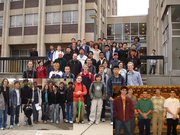06-240/Term Test: Difference between revisions
From Drorbn
Jump to navigationJump to search
m (Reverted edit of 221.203.53.51, changed back to last version by Drorbn) |
No edit summary |
||
| Line 37: | Line 37: | ||
'''Problem 2.''' |
'''Problem 2.''' |
||
# In the field <math>{\mathbb C}</math> of complex numbers, compute <center><math>\frac{1}{2 |
# In the field <math>{\mathbb C}</math> of complex numbers, compute <center><math>\frac{1}{2 3i} \frac{1}{2-3i}</math> |
||
# Working in the field <math>{\mathbb Z}/7</math> of integers modulo 7, make a table showing the values of <math>a^{-1}</math> for every <math>a\neq 0</math>. |
|||
'''Problem 3.''' Let <math>V</math> be a vector space and let <math>W_1</math> and <math>W_2</math> be subspaces of <math>V</math>. Prove that <math>W_1\cup W_2</math> is a subspace of <math>V</math> iff <math>W_1\subset W_2</math> or <math>W_2\subset W_1</math>. |
|||
'''Problem 4.''' In the vector space <math>M_{2\times 2}({\mathbb Q})</math>, decide if the matrix <math>\begin{pmatrix}1&2\\-3&4\end{pmatrix}</math> is a linear combination of the elements of <math>S=\left\{\begin{pmatrix}1&0\\-1&0\end{pmatrix},\ \begin{pmatrix}0&1\\0&1\end{pmatrix},\ \begin{pmatrix}1&1\\0&0\end{pmatrix}\right\}</math>. |
|||
'''Problem 5.''' Let <math>V</math> be a finite dimensional vector space and let <math>W_1</math> and <math>W_2</math> be subspaces of <math>V</math> for which <math>W_1\cap W_2=\{0\}</math>. Denote the linear span of <math>W_1\cup W_2</math> by <math>W_1+W_2</math>. Prove that <math>\dim(W_1+W_2)=\dim W_1 + \dim W_2</math>. |
|||
<center> '''Good Luck!''' </center> |
|||
{{06-240/Results of the Term Test}} |
|||
==Solution Set== |
|||
Students are most welcome to post a solution set here. |
|||
Solutions posted by me, feel free to make any changes: |
|||
'''Problem 1.''' <math>0_F\cdot v=(0_F+0_F)\cdot v</math> (by F3) |
|||
<math>(0_F+0_F)\cdot v=0_F\cdot v+0_F\cdot v</math> (by VS8) |
|||
By VS4, <math>\exists\ (0_F\cdot v)' s.t. (0_F\cdot v)+(0_F\cdot v)'=0_V</math> |
|||
Add <math>(0_F\cdot v)'</math> to both sides of <math>0_F\cdot v=0_F\cdot v+0_F\cdot v</math> |
|||
<math>(0_F\cdot v)'+(0_F\cdot v)=[(0_F\cdot v)'+0_F\cdot v]+0_F\cdot v</math> |
|||
<math>0_V=0_V+0_F\cdot v</math> (by construction) |
|||
<math>0_V=0_F\cdot v</math> (by VS3) |
|||
'''Problem 2.''' 1) <math>\frac{1}{2+3i}+\frac{1}{2-3i}=\frac{(2-3i)+(2+3i)}{(2+3i)(2-3i)}=\frac{4}{2^2+3^3}=\frac{4}{13}</math> |
|||
<math>\frac{1}{2+3i}-\frac{1}{2-3i}=\frac{(2-3i)-(2+3i)}{(2+3i)(2-3i)}=\frac{-6i}{2^2+3^3}=-\frac{6}{13}i</math> |
|||
2) <math>1^{-1}=1</math> |
|||
<math>2^{-1}=4</math> |
|||
<math>3^{-1}=5</math> |
|||
<math>4^{-1}=2</math> |
|||
<math>5^{-1}=3</math> |
|||
<math>6^{-1}=6</math> |
|||
'''Problem 3.''' First suppose <math>W_1\subset W_2</math> or <math>W_2\subset W_1</math>, then <math>W_1\cup W_2</math> equals <math>W_2</math> or <math>W_1</math>. Either case <math>W_1\cup W_2</math> is a subspace of <math>V</math>. |
|||
Now suppose <math>W_1\cup W_2</math> is a subspace of <math>V</math> and neither <math>W_1\subset W_2</math> nor <math>W_2\subset W_1</math>. It must follows <math>\exists\ x\in W_1</math> s.t. <math>x</math> is not in <math>W_2</math> and <math>\exists\ y\in W_2</math> s.t. <math>y</math> is not in <math>W_1</math>. Since <math>x,y\in W_1\cup W_2</math>, <math>x+y\in W_1\cup W_2</math>. If <math>x+y\in W_1</math>, then <math>\exists\ -x\in W_1</math> s.t. <math>(-x)+x+y\in W_1</math> and <math>(-x)+x=0</math>, so <math>y\in W_1</math>, a contradiction. If <math>x+y\in W_2</math>, then <math>\exists\ -y\in W_2</math> s.t. <math>x+y+(-y)\in W_2</math> and <math>(-y)+y=0</math>, so <math>x\in W_2</math>, a contradiction. Therefore either <math>W_1\subset W_2</math> or <math>W_2\subset W_1</math>. |
|||
'''Problem 4.''' Suppose <math>\begin{pmatrix}1&2\\-3&4\end{pmatrix}</math> is a linear combination of <math>\begin{pmatrix}1&0\\-1&0\end{pmatrix}</math>, <math>\begin{pmatrix}0&1\\0&1\end{pmatrix}</math>, and <math>\begin{pmatrix}1&1\\0&0\end{pmatrix}</math>, then <math>\exists\ a_1, a_2, a_3\in F</math> s.t. <math>\begin{pmatrix}1&2\\-3&4\end{pmatrix}=a_1\begin{pmatrix}1&0\\-1&0\end{pmatrix}+a_2\begin{pmatrix}0&1\\0&1\end{pmatrix}+a_3\begin{pmatrix}1&1\\0&0\end{pmatrix}</math>. |
|||
<math>\mbox{Need to solve}\begin{cases} |
|||
1=a_1^{}+a_3^{}\\ |
|||
2=a_2^{}+a_3^{}\\ |
|||
-3=-a_1^{}\\ |
|||
4=a_2^{}\end{cases}</math> |
|||
Solving the equations yields <math>a_1=3</math>, <math>a_2=4</math>, <math>a_3=-2</math>, so <math>\begin{pmatrix}1&2\\-3&4\end{pmatrix}</math> is a linear combination of <math>\begin{pmatrix}1&0\\-1&0\end{pmatrix}</math>, <math>\begin{pmatrix}0&1\\0&1\end{pmatrix}</math>, and <math>\begin{pmatrix}1&1\\0&0\end{pmatrix}</math>. Specifically, <math>\begin{pmatrix}1&2\\-3&4\end{pmatrix}=3\begin{pmatrix}1&0\\-1&0\end{pmatrix}+4\begin{pmatrix}0&1\\0&1\end{pmatrix}-2\begin{pmatrix}1&1\\0&0\end{pmatrix}</math>. |
|||
'''Problem 5.''' Since <math>V</math> is finite-dimensional, then so are <math>W_1</math> and <math>W_2</math> and their basis. Let <math>{a_1, a_2,..., a_m}</math> be the basis of <math>W_1</math> and <math>{b_1, b_2,..., b_n}</math> be the basis of <math>W_2</math> so <math>\dim W_1=m</math> and <math>\dim W_2=n</math>. |
|||
We know <math>{a_1, a_2,..., a_m}</math> and <math>{b_1, b_2,..., b_n}</math> are linearly independent and clearly <math>{a_1, a_2,..., a_m, b_1, b_2,..., b_n}</math> spans <math>W_1+W_2</math>. If <math>{a_1, a_2,..., a_m, b_1, b_2,..., b_n}</math> is linearly dependent, then there exist not all zero coefficients <math>c_1, c_2,..., c_{m+n}\in F</math> s.t. <math>c_1 a_1+c_2 a_2+...+c_m a_m+c_{m+1} b_1+c_{m+2} b_2+...+c_{m+n} b_n=0</math>. Then some linear combinations of <math>{a_1, a_2,..., a_m}</math> with not all zero coefficients can be expressed in linear combinations of <math>{b_1, b_2,..., b_n}</math>, but this would imply <math>W_1\cap W_2\neq \{0\}</math>, a contradiction. Therefore <math>{a_1, a_2,..., a_m, b_1, b_2,..., b_n}</math> is a linearly independent set that spans <math>W_1+W_2</math>, it's the basis of <math>W_1+W_2</math>. We have <math>\dim (W_1+W_2)=m+n=\dim W_1+\dim W_2</math>. |
|||
Revision as of 01:40, 28 May 2007
| ||||||||||||||||||||||||||||||||||||||||||||||||||||||
The Test
Front Page
Do not turn this page until instructed.
Math 240 Algebra I - Term Test
University of Toronto, October 24, 2006
Solve the 5 problems on the other side of this page.
Each of the problems is worth 20 points.
You have an hour and 45 minutes.
Notes.
- No outside material other than stationary and a basic calculator is allowed.
- We will have an extra hour of class time in our regular class room on Thursday, replacing the first tutorial hour.
- The final exam date was posted by the faculty - it will take place on Wednesday December 13 from 2PM until 5PM at room 3 of the Clara Benson Building, 320 Huron Street (south west of Harbord cross Huron, home of the Faculty of Physical Education and Health).
Questions Page
Solve the following 5 problems. Each of the problems is worth 20 points. You have an hour and 45 minutes.
Problem 1. Let be a field with zero element , let be a vector space with zero element and let be some vector. Using only the axioms of fields and vector spaces, prove that .
Problem 2.
- In the field of complex numbers, compute








